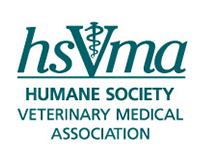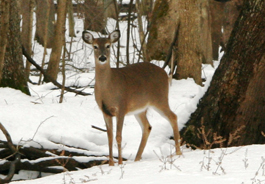|
Advocacy
|
Panda Chronicles
A Veterinarian’s Firsthand Perspective on the Health and Welfare
of Giant Pandas in China’s Breeding Industry
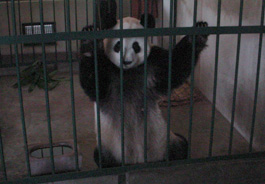 A giant panda mother named Yaya follows the cub that has just been taken from her. She wants her baby back. Dr. Kati LoefflerMarch 19, 2015
by Kati Loeffler, DVM, PhD, MRCVS
Few creatures are more helpless than newborn giant panda cubs. They disappear in the palm of their mother’s gentle paw. They have no functioning immune system. They are blind, deaf, hairless, and unable to propel their little bodies. What they do have is a voice that’s ten times the size of their bodies, and a very big mouth for suckling. A panda mother’s attentions are imperative, and a panda baby isn’t going to let her forget it – not that she ever would.
One of the most poignant events that we witness in our work as veterinarians is a mother’s acceptance of her newborn, and the beginning of the maternal bond. The maternal investment of giant pandas is tremendous. Mothers hold their cubs in their great paws without ever letting them touch the ground for weeks. Giant pandas have not evolved to go without food for long periods of time, but panda mothers may remain in the nest for as long as two weeks after an infant’s birth, foregoing both food and water.
The giant panda breeding industry in China does not see poignancy in the maternal moment, nor does it appreciate the inborn expertise that animal mothers possess to care for their offspring. The industry’s prevailing attitude toward animal care is that humans always know better what the animal should be doing than the animal does herself. There is fundamentally no respect within the industry for the sentience of animals, nor for their inherent skills that have been honed over millions of years of evolution.
I began working with giant pandas nearly 15 years ago, as a somewhat idealistic research veterinarian affiliated with the Smithsonian Institution. My project was to investigate infectious diseases of giant pandas in China. At that time, infant mortality rates were high, pandas failed to thrive, and visiting tourists viewed dull, lethargic animals. I arrived at the giant panda breeding facility in Chengdu with enthusiastic plans and great expectations for the importance of our research.
Within 24 hours of my arrival, I found myself watching a giant panda whose newborn cub had just been torn from her by the keepers. She was trying to bury her face in the corner of her fluorescent-lit cement cell with bars on three sides and no privacy, peace, or comfort. I realized then that my job was not as much about understanding disease or improving health, as it was to figure out how to turn panda welfare into profit. I had come face-to-face with the realities of the giant panda breeding industry, and there is nothing cute and fluffy about it.
Forced Maternal Neglect
That cub was dead a few days later. The common practice at that time was to remove cubs the moment they were born, because panda mothers were considered unfit to raise them. They were placed in an incubator and fed human baby formula. If they didn't die of failure of passive transfer, they died of diarrhea and malnutrition. In effect, they died of forced maternal neglect, ironically imposed by humans whose objective was to breed pandas in order to save the species.
|
In the panda breeding industry, the emphasis is on cub numbers... To ensure that females come into estrus [each] spring, their cubs are taken from them...[some at] only three months old [when they are] just beginning to take their first wobbly steps.
|
In the wild, cubs remain with their mothers for at least 18 months. During that time the panda mother does not mate, and invests all her energies in raising a single, healthy cub that is physically and socially fit to thrive independently. Thus, female pandas raise a cub on average once every four years. In the panda breeding industry, the emphasis is on cub numbers, and to breed each mature female every year. To ensure that females come into estrus in the spring, their cubs are taken from them by the preceding December. Some cubs are only three months old—just beginning to take their first wobbly steps. The inhumanity of forced artificial reproduction methods – artificial insemination and sperm collection – for male and female pandas is a topic for another article.
I campaigned hard for cubs to at least be allowed colostrum, if not full maternal care. I provided literature on the necessity of passive transfer, and garnered the support of my colleagues at the Smithsonian and at other American zoos exhibiting pandas. Our Smithsonian pathologist established that cubs were dying of sepsis associated with a lack of immune defense. If nothing else, I suggested in a desperate moment, at least give cubs maternal serum, as we sometimes do for orphaned neonatal calves and foals.
No, was the answer from the breeding facility management. Despite the fact that cub survival was extremely poor, there was a refusal to hear us, to believe us, to try anything different. Greatly to their credit, some of the breeding center staff were eager to try my suggestions. But they couldn’t shake the status quo and the general fear of changing anything, lest it go from bad to worse and someone have to catch the blame.
NEXT: Misguided Preventive Care and Nutrition»
«First 1 2 3 Last» |
|
Advocacy
|
Panda Chronicles
Part 2 of 3
Misguided Preventive Care and Nutrition
Basic preventive health care was another topic that I worried from every angle. Deworming. Vaccination. Nutrition. Stress.
Deworming was accepted, but only for animals older than six months and for females who were definitely not pregnant or who had recently delivered. This policy essentially overlooked the most critical segments of the population. The only dewormer deemed acceptable was ivermectin delivered by injection—thus, difficult and highly stressful to administer. I struggled to convince the veterinary staff to try oral administration, disguising the drug in a honey or apple mush treat. I watched a new mother discharge a bolus of ascarids, and my colleagues demonstrated visceral larva migrans in cubs. I was asked what to do about pandas who vomited worms. Adoption of a commonsense deworming protocol that utilized various drugs and that covered cubs and pregnant animals in particular was rejected as inappropriate: too risky.
If animals were vaccinated at all, it was with the modified-live canine distemper vaccine developed by a Chinese university. No one liked the vaccine because it seemed to make pandas sick. It killed animals like red pandas outright after triggering a full-blown course of distemper. Many giant panda cubs had lesions on their teeth that mimicked the distemper lesions seen in puppies. I contacted the pharmaceutical firm Merial, which was happy to support the panda center with its recombinant canine distemper vaccine. I argued for the use of this vaccine and explained why the recombinant type was the safest option. But my logic did not prevail. It was considered too risky to try something different.
Pandas were chronically unwell, colicky, and stunted. Demodecosis ringed their eyes. They passed painful, mucoid stools and went off their food. My colleagues and I were asked for special drugs, scientific breakthroughs, and nutritional secrets, but ears closed against our emphasis on maternal care, natural foods, behavior-based husbandry, and sound preventive health practices. The animals were fed porridge, milk, and meat cakes formulated by the center’s nutritionists and steamed in the kitchen. Micronutrients were supplemented to the extent that one year several pandas died of toxicity. Reproductive rates were nearly zero. Bamboo was restricted in favor of more “nutritious” food. Milk and meat were best for humans, the logic went, so this was best for pandas too.
|
My colleagues and I were asked for special drugs, scientific breakthroughs, and nutritional secrets, but ears closed against our emphasis on maternal care, natural foods, behavior-based husbandry, and sound preventive health practices.
|
My colleagues and I patiently chanted “Bamboo, bamboo, bamboo.” Feed the right species of bamboo and the right parts – shoots, leaves and stems – at the right times of year. Cut out the milk: adult mammals do not naturally drink milk. Mind the vitamins and minerals: more is not necessarily better. Cut out the meat cakes. Think scientifically about what pandas eat in the wild. But the attitude was that animals in the wild are deprived: the poor wild pandas have nothing else to eat out there but bamboo, and we humans should give them better food.
Even water was restricted. It was thought that if pandas were allowed to drink as much as they wanted, they would drink too much and “get drunk”. As proof, a panda let into an enclosure had been observed to make a straight line to the pool and drink until he sank to the ground with relief.
My colleagues and I argued and pleaded that pandas need a lot of water to process their rough food. They must be able to drink whenever they want to drink. If they are allowed to drink at will, they won’t drink too much at any one time. In this way they are just like us: if you sip at your tea all day, it will keep you hydrated and feeling well. No, was the response. It is too dangerous.
Cubs were given human infant formula made of cow’s milk. They were colicky, refused to eat, didn’t grow, had diarrhea, and died. Goat’s milk was tried. The cubs were then injected with antibiotics and mysterious Chinese drugs. High-tech research was considered the solution, so when a rotavirus was isolated from a cub’s diarrhea, it was thought that the cause of the diarrhea had been found and all that was needed was to administer a drug to kill rotavirus. My sermons on factors predisposing domestic animals to rotavirus infection and how to control it – essentially, with good husbandry, hygiene, and the food they need from their mothers – was considered insulting. I begged to at least try a mixture of puppy milk formula recommended by the board-certified nutritionist from the San Diego Zoo. Unfortunately, the tin of Esbilac® I offered was treated with the politeness one might reserve for a tin of poison.
Stress
And oh, the stress under which these animals suffer from so much being wrong, all day, every day. They have nowhere to climb, no way to get off the cement floor, not a bit of privacy, nothing to do. They feel sick from eating the wrong foods, from parasites, chronic boredom, and the relentless proximity of humans. They suffer the crush of human noise, smell, hands, violence, cigarette smoke, camera flash, lights. The pandas eat, sleep, and exist all day in front of tourists: after all, that is considered their job. For some pandas, the night brings merciful dark and silence. But not for the cubs, and not for pregnant females or new mothers. For them, the lights and smoke and noise and human presence continue unbroken 24 hours a day: they are observed around the clock by shifts of keepers. This vigilance is thought to demonstrate that everything is being done to keep the animals safe.
NEXT: Hope for Change»
«First 1 2 3 Last» |
|
|
Advocacy
|
Panda Chronicles
Page 3 of 3
Hope for Change
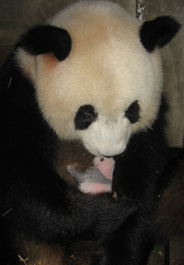 A giant panda mother cradles her week-old cub. Dr. Kati LoefflerI finished my infectious disease study that had been pared down to a serologic survey based on extremely hard-won samples and an excruciating year setting up cell cultures and virology assays at a local university. But I returned to the breeding facility in different roles, like a specter that wouldn’t go away.
I continued my mantra about nutrition, stress, deworming, and maternal care. My colleagues reiterated it. A study on maternal care by a behaviorist at Zoo Atlanta was permitted, for which a few mothers were allowed to keep their cubs for a full year. The study was designed to see how the cubs fared, particularly when they became parents themselves.
At last, the colostrum suggestion was sniffed at, slowly absorbed, and risked. And cubs survived. Round, fluffy cubs tumbled in the nursery, tourists squealed, cameras clicked and money poured in.
The cubs did better until they were taken from their mothers, and then their colic, diarrhea and reluctance to eat began. Suddenly, one summer, the Esbilac® recipe was adopted, and then the formula was imported in shipping containers. Panda cubs fared better and grew better.A British professor interested in protein chemistry won support for a study of panda milk. He suggested that the proteins in a panda mother’s milk — including immune factors and gut protectants: galaxies of evolutionary and ontogenic precision — were certain to change as the panda cub develops. The emphasis on applying this research is to demonstrate the importance of allowing mothers to feed their cubs naturally, with full maternal care, and of keeping panda mothers healthy. As we work toward publication of this research today, we struggle to counterbalance the motivation of the giant panda breeding industry to discover a proprietary artificial milk formula that will raise big, rapidly-maturing cubs who don’t need a mother. Rather like, when one thinks about it, agribusiness chickens or calves or piglets.
Winning the battle over colostrum was monumental, and it felt like a major breakthrough. The other battle we waged was over bamboo.
In the end, it was the director of the panda breeding center himself who stood up to the husbandry and nutrition departments. Our pandas are sick, and reproductive rates are rock bottom: we’re going to feed them what they eat in the wild, he announced. His staff writhed and protested and threatened mutiny. No one wanted the responsibility if anything went wrong. The director assumed full responsibility and ordered the changes. He lost his hair and his voice, and he developed shingles and heart disease from the stress over the risk he was taking. But he was rewarded: the animals brightened and grew stronger, reproductive rates improved, and visitors now love watching pandas munch their way through mounds of bamboo.
Merial’s recombinant distemper vaccine was ordered. After all our struggle to get it accepted, I was one day sagely informed by a young member of the veterinary staff that the canine modified-live virus vaccine was dangerous to use in pandas, and that the recombinant vaccine was much better. Indeed, I said, that’s excellent to know.
On the parasite front we still struggle, but at least ivermectin is given orally now, to some animals once a month, but to cubs it is still given too late, and to pregnant mothers, not at all.
I argued science, welfare, physical fitness – once even through tears – to enhance the enclosures and to let the pandas choose whether to go outdoors or to stay in, and with the option of privacy. Too dangerous, I was told. Pandas might fall off climbing platforms, freeze to death, or bake in the heat. They can’t be trusted to make decisions for their own health and comfort. I convinced the director to visit the peerless Animals Asia Foundation’s black bear sanctuary, to see its enclosures and observe the behavioral enrichment program there. He took a posse of husbandry staff, and returned with a camera full of photographs. As a result, climbing frames, pools, and foliage sprang up in the panda enclosures. Pandas lounged above the ground, and cubs played vertically. Tourists squealed, clicked photos and spent their money.
The Future of Giant Pandas
China’s panda breeding facilities still want for major improvements, particularly in veterinary care, humane animal handling, behavior-based husbandry, maternal welfare and behavioral development. The infamous reproductive “problems” of captive giant pandas result from a combination of inbred genetics, highly unnatural social environments during critical developmental periods, and irrational expectations of giant panda reproductive capacity.
The animals at the two major breeding centers are somewhat healthier now, reproductive output has improved, and cub survival is good. The panda industry takes in millions annually. But this is a bittersweet improvement. More cubs now survive, but to live what kind of lives? They are still behind bars, exhibited before hordes of tourists, traded as political pawns, and rented for millions per year.
|
More cubs now survive, but to live what kind of lives? They are still behind bars, exhibited before hordes of tourists, traded as political pawns, and rented for millions per year.
|
Breeding animals for the purpose of releasing them into the wild serves no purpose without ongoing protection and restoration of appropriate habitats, without respect for the rights of wild animals to exist in their own spaces, and without the animals’ ability to live as freely from humans as possible. If the habitats into which pandas can be reintroduced are insufficient and vulnerable, then continued production of cubs simply means that more pandas will spend their lives in captivity.
When I last visited the panda breeding facility a year or so ago, I asked a young keeper how the new cubs were doing. She glanced at a panda mother sitting on the cement floor, gently licking a tiny creature in her great, gentle paw. “Very well,” the keeper said. Her face beamed. “It is very important for cubs to drink the first milk from the mother. Then they can be strong.”
«First 1 2 3 Last»
Dr. Kati Loeffler works with the International Fund for Animal Welfare to improve the welfare of domestic animals and wildlife in developing regions around the world. Her efforts concentrate on animal rescue and rehabilitation, and on raising standards of veterinary capacity in underserved communities. Central to her initiative is IFAW’s leadership in the One Welfare concept, which hinges on the interdependence of human and animal well-being, individually and in communities. |
|
Advocacy
|
HSVMA Urges Veterinary Support for Legislation to Protect Farm Animals Used in Agricultural Research
New York Times Exposé Reveals Egregious Abuse
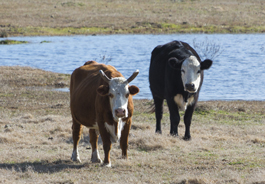 A recent New York Times esposé revealed decades of brutal treatment of farm animals used for research at a taxpayer-financed federal facility in Nebraska. JP Bonnelly February 23, 2015
The Humane Society Veterinary Medical Association urges veterinary professionals to join us in supporting federal legislation that would ensure that farm animals used for agricultural research at federal facilities receive at least the basic care required under the Animal Welfare Act.
The AWARE Act, or Animal Welfare in Agricultural Research Endeavors Act, was introduced this month in the aftermath of a January 19 New York Times exposé that revealed decades of horrific treatment of farm animals used for research at a federal facility in Nebraska. The U.S. Meat Animal Research Center, which has received almost $200 million in federal funding just since 2006, was found to have allowed at least 6,500 animals to die from starvation and to have conducted inhumane research on pigs, cows and other farm animals.
Some of the more egregious examples of the brutal treatment the animals received include putting pigs in steam chambers until some of them perished, leaving lambs abandoned by their overtaxed mothers in pastures to die from neglect, severe weather, and predators, breeding calves with deformities, and allowing untrained, unsupervised staff to perform experimental surgery.
| The brutal treatment that so many of these animals endured in the name of research is unacceptable. The AWARE Act takes the first steps to address this inhumanity by closing the loophole in the Animal Welfare Act that exempted these animals from basic protections. It makes common sense for the veterinary profession to strongly support this much-needed reform. |
The Nebraska center, which was founded 50 years ago by Congress, conducts research to maximize the production of animals for the meat industry. Currently, the Animal Welfare Act exempts farm animals “used or intended for use for improving animal nutrition, breeding, management, or production efficiency, or for improving the quality of food or fiber.” USDA is responsible for overseeing enforcement of the AWA at non-federal research facilities conducting biomedical research, such as those seeking a cure to cancer. It makes no sense for USDA-conducted research designed to boost meat industry profits to be exempt from the law’s modest welfare protections.
“The brutal treatment that so many of these animals endured in the name of research is unacceptable,” said Dr. Barry Kellogg, HSVMA Senior Veterinary Advisor. “The AWARE Act takes the first steps to address this inhumanity by closing the loophole in the Animal Welfare Act that exempted these animals from basic protections. It makes common sense for the veterinary profession to strongly support this much-needed reform.”
The Times report was based on Freedom of Information Act requests and information obtained from current and former employees associated with the research facility, including one veterinarian who spent 25 years at the facility. These whistleblowers shared stories of cruelty and neglect that, at times, were ignored by supervisors.
How You Can Help
The AWARE Act (H.R. 746) was introduced in the U.S. House of Representatives by Reps. Earl Blumenauer (D-Oregon), Mike Fitzpatrick (R-Pa.), Vern Buchanan (R-Fla.), and Louise Slaughter (D-N.Y.). A companion bill (S. 388) was introduced in the U.S. Senate by Sen. Cory Booker (D-N.J.) and Richard Blumenthal (D-Conn.)
Please contact your federal legislators and urge them to support this important legislation. As a veterinary professional and expert in issues pertaining to animal health and welfare, your input will be especially important in moving this bill forward.
Please make a brief phone call to your two U.S. Senators and your U.S. Representative and urge them to cosponsor these bills to protect farm animals used in agricultural research (find your legislators' phone numbers here). It is important to indicate you are a veterinary professional and a constituent when calling and to reference the AWARE (Animal Welfare in Agricultural Research Endeavors) Act – H.R. 746/S. 388.. For more background, review the HSVMA support letter for this legislation»
After making your call, it would be helpful to also personalize and submit a follow-up message using this form»
Thank you for taking the time to help move this important animal welfare reform forward. |
|
